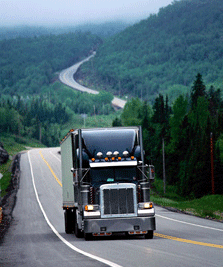Golden Rules Of Trucking Safety: Speed and Following Distance
-
Blogs By Author
-
Blogs By Tag
This article is co-authored by Brett Aquila and TruckerMike.
From TruckerMike
In day two of truck driving school, I had said:
It was almost all about "defensive driving" techniques while in a big rig. We watched several videos on jackknifing, winter weather driving, how to make turns and drive in a congested city, some more on backing techniques, etc. The video we watched on winter driving sort of freaked some of my fellow classmates out. Now, we're all from the Chicago area, so we aren't new to snow, ice, and cold. But this video was not shy on showing some very bad accidents involving semis. The video about rollover accidents was the same way. It was very interesting to see some of the reactions in class. I thought one guy was going to puke and walk right out.
The main thing I've seen in these videos is excessive speed! Almost all of the accident videos I've seen online were most definitely the result of excessive speed. My classroom instructor drove that point home today. He asked an interesting question. He asked, "What type of weather condition do you think I saw the worst accidents in while I was on the road?" Since we were on the subject of winter driving, I jumped in and said "ice," another student said "fog," another one said "snow." These were all wrong. He said hands down, the nastiest accidents he's seen occur are in rain! Of all things. The reason being, people just drive too fast. People are used to rain so they typically drive the same speed as if the pavement was dry. When it snows, people typically slow down. So even though the quantity of accidents may be more on snowy roads, the accidents that do occur in rain tend to be much more serious. He didn't have any stats on that, just personal experience. Slow it down people!
He tried to assure us that this doesn't have to be a dangerous job and the purpose of the video wasn't to try and scare us. It's complacency, speed, and impatience that gets people hurt and killed. Most truck driving accidents occur due to excessive speed and rollover. Most of those rollovers are on highway off ramps. Drivers just enter them too quick, the center of gravity is too high, and they tip. Yes, rollovers do occur due to semis being cut off by vehicles, forcing them to swerve to miss an accident. But most rollovers are simply caused by a driver's excessive speed and inattention to the road. Even in winter conditions, speed is usually the main factor. A good quote from my instructor - "you can go too slow as many times as you want, but you can only go too fast once." Good point.
From Brett Aquila

TruckerMike's instructor has a good point - most of the worst accidents you'll see are in the rain. Excessive speed is most commonly associated with breaking the speed limit, but when it comes to commercial vehicles, the most critical factors that should determine your speed are weather, road, and traffic conditions. However, going hand in hand with excessive speed is following distance, which in my opinion is a critical factor in avoiding accidents. The weather, road, and traffic conditions should determine the safest speed to be traveling at. The conditions, combined with the speed you are traveling at, should determine your following distance.
I can't tell you how many times in my 15 years of safe driving that I was incredibly thankful for having maintained a safe following distance. Man have I seen some unbelievable wrecks happen right in front of me! But because I was a safe distance behind those vehicles, I was always able to avoid getting involved. I'm not going to go into the exact calculations they use in the CDL manual to determine stopping distance based on speed and road conditions, how many seconds you should be behind somebody, and all of that. That information is easy enough to find. What I am going to say is that keeping a safe following distance will save your ass time and time again! If I had to pick one rule to be my golden rule of safety it would be to maintain a safe following distance.
You must have patience when driving a big rig. You can not get anxious and start "pushing" the people in front of you to get moving by tailgating them. You can not assume that nothing is about to happen. You have to assume the worst is about to happen directly in front of you at all times and keep a safe speed and distance. If you ignore these principles, sure as can be, you're going to get into a wreck.
Related Articles:







 TT On Facebook
TT On Facebook